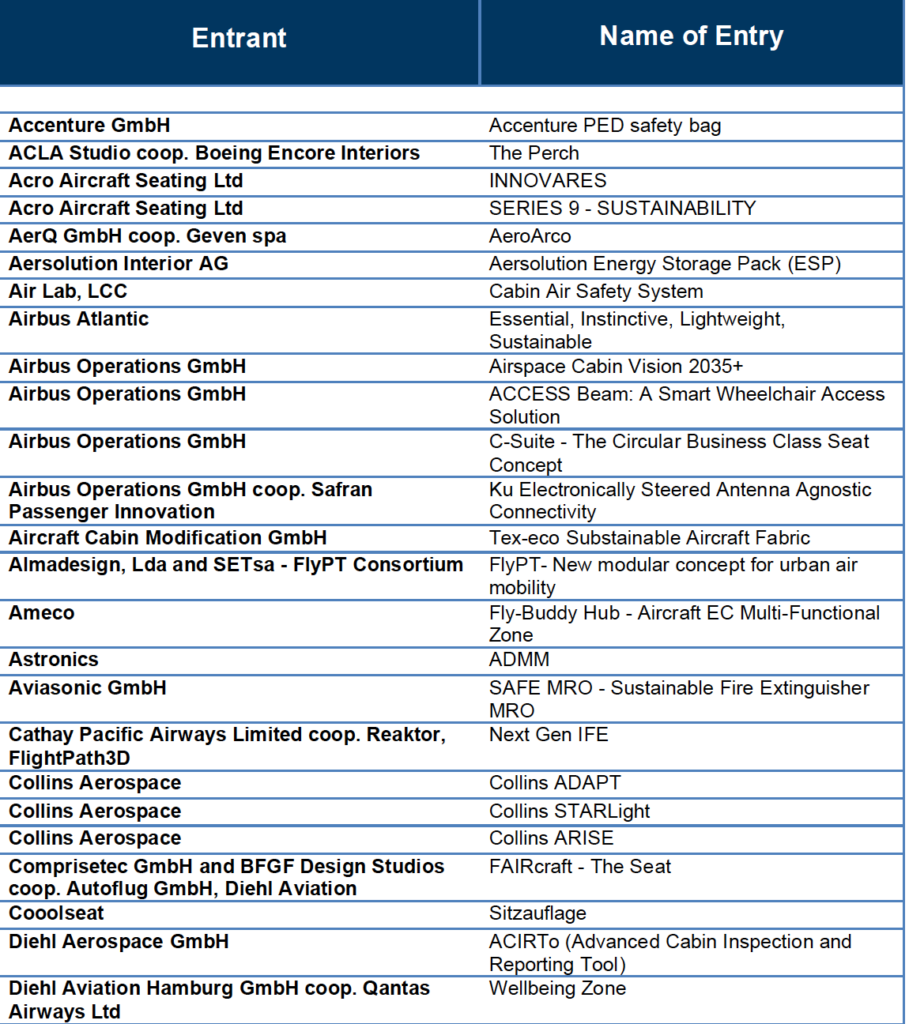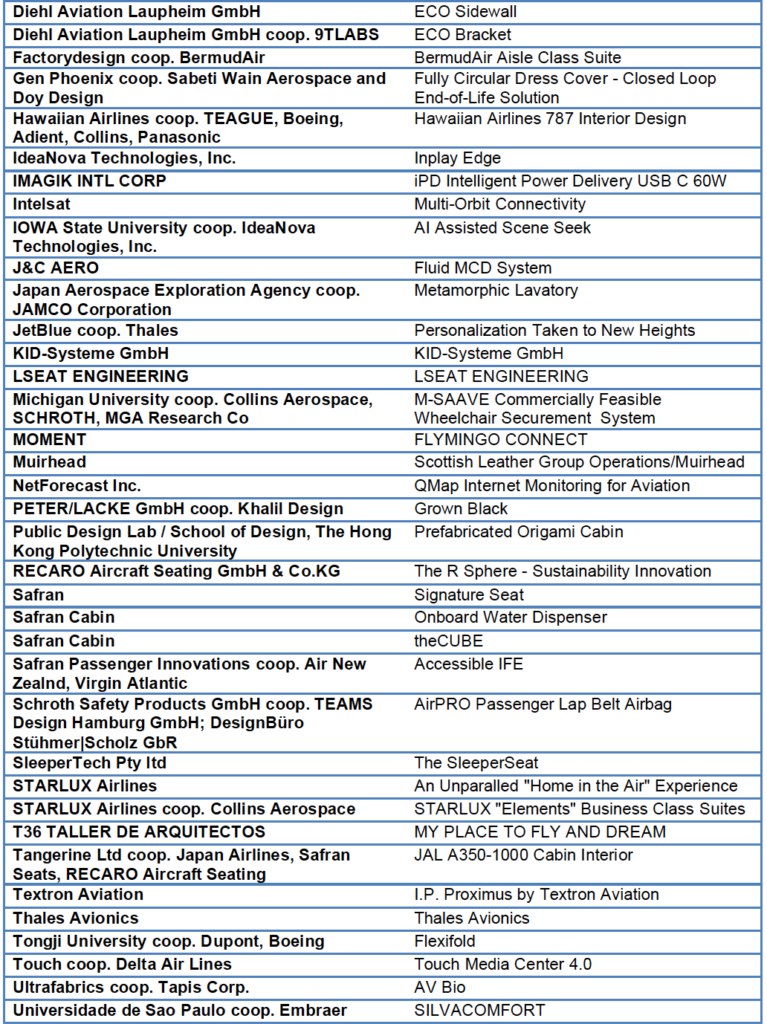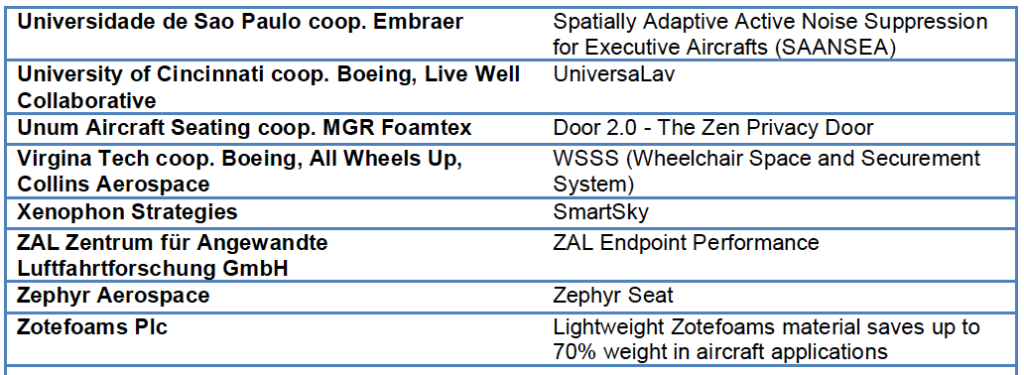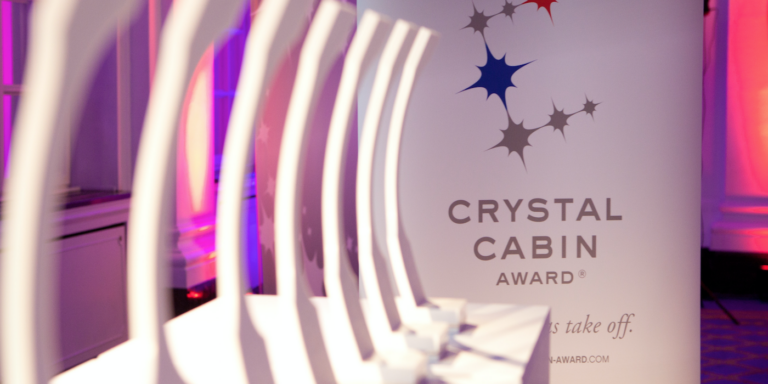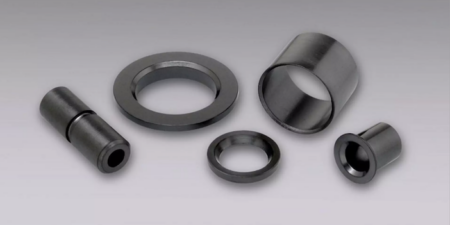The Crystal Cabin Awards, widely considered to be the most prestigious accolade of aircraft cabin innovation, are returning in May, and the shortlist has just been revealed. Previous winners of the annual event, organised by Hamburg Aviation, include some of the biggest names in aviation, such as Airbus, Air New Zealand, United Airlines, Qatar Airways, Diehl Aviation, Etihad and Boeing. You can view the winners of the 2023 awards HERE.
Following an initial vetting process, 72 entries have made it through to the 2024 shortlist, split into eight categories: Cabin Concepts, Cabin Systems, Health & Safety, IFEC & Digital Services, Material & Components, Passenger Comfort, Sustainable Cabin, and University.
An international panel of experts has now begun assessing the hopefuls before a round of voting decides the three finalists for each category. The next step, taking place in Hamburg in May, is an in-depth, in-person round of evaluation and voting, after which the eight winners are decided.
While the 72-strong shortlist reflects a wide range of innovations, from seating concepts to cabin materials and IFE systems, there are common threads of making the flight experience more comfortable, sustainable and progressive.
The full shortlist is below. In no particular order, themes of the 2024 Crystal Cabin Awards shortlist include:
Comfort in economy class
There are some amazing luxury experiences to be enjoyed in the sky, but the majority of air travellers are interested in how the economy-class experience can be enhanced. A fantastic design won last year, namely Air New Zealand’s Skynest bunk beds (a few details here).
Ideas competing this year include Ameco’s Fly-Buddy Hub, a social seating concept in which six passengers can sit opposite each other. The modular design creates a versatile space with convertible seats and beds, folding tables, a roll-up screen, and intelligent partitions – and a potential source of extra revenue.
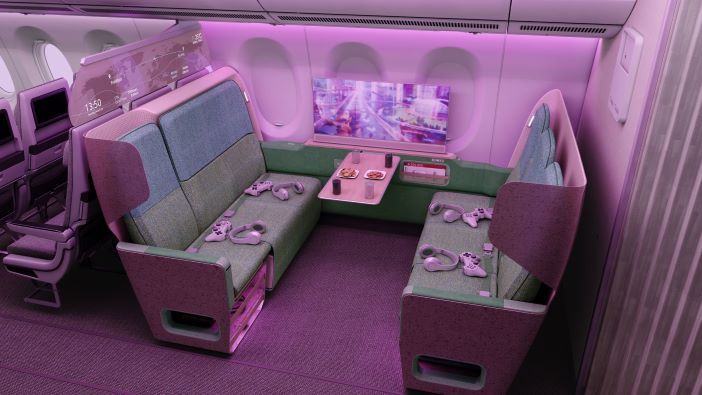
Qantas Airways is due to begin offering non-stop ‘Project Sunrise’ flights from Sydney and Melbourne to London and New York by the end of 2025 (although there are a few rumours of a delayed entry into service). With these flights lasting upwards of 19 hours, comfort is a priority, so Diehl Aviation has designed an innovative Wellbeing Zone for the A350-1000s due to operate the routes. The Wellbeing Zone (some more images here) is accessible to travellers from all travel classes (and is likely to be most appreciated by economy ticket holders), offering space for a guided exercise programme on screens, a drinking station and a range of healthy snacks – or simply room to stretch, unwind and socialise.
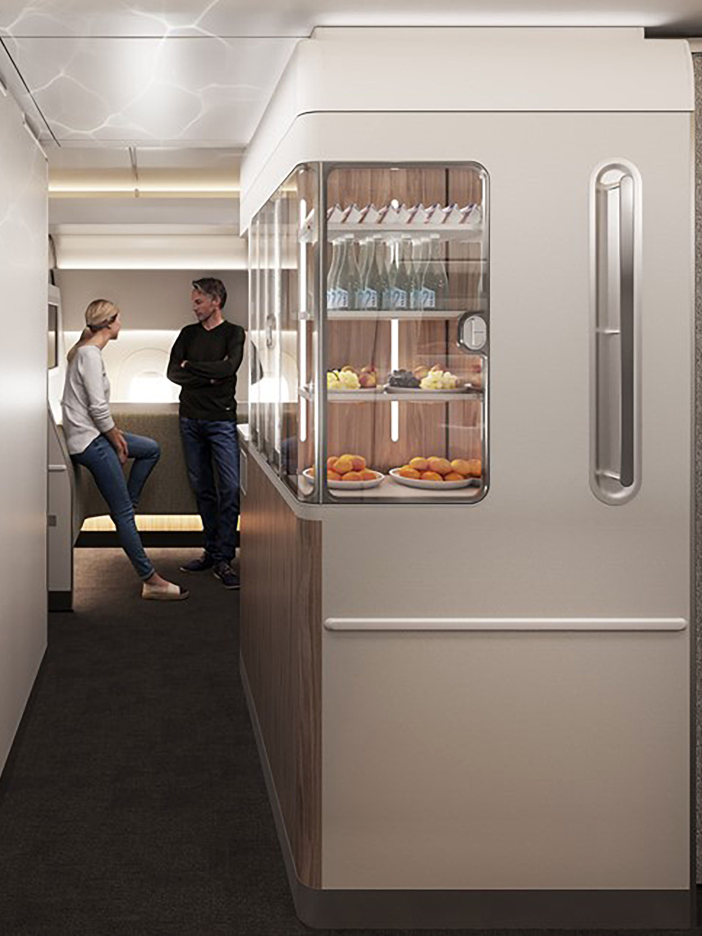
…and in premium economy
On a long flight every passenger wants privacy and the opportunity to lie down to sleep. This is easily attainable in first or business class, (though at a high fare), but what of the cabins further back in the plane? Zephyr Aerospace says it is set to deliver these comfort features in premium economy class, with its Zephyr seat (you can see a video explainer here). The company says it is the world’s first flat aircraft seat for long-haul flights in premium economy class, with the deign also offering direct access to the aisle (no stepping over neighbours’ laps to get to the lavatory), and complete privacy for every traveller. The company claims that the stacked design of the seat – which is still in the development stage – means that it can be installed in an aircraft cabin without losing seat count.
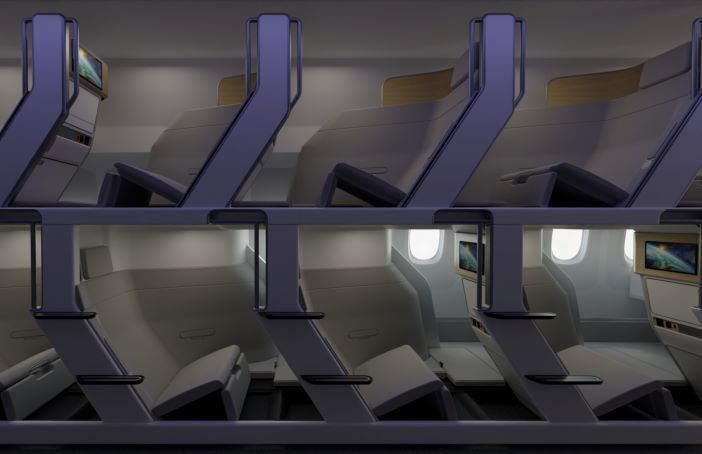
Japan Airlines has also considered the comfort of premium economy passengers travelling in its new A350-1000s, with automatic electric seat adjustment and a fixed partition between the seats in the middle of the cabin to maximise privacy. The comfort story continues, with the cabin design partner – British design agency Tangerine – helping the airline introduce Japanese innovation across all four travel classes: First, Business, Premium Economy and Economy. Completely redesigned seats can be found in all classes. In Business and First Class, travellers can enjoy the first headphone-free inflight entertainment system, enabled by in-seat loudspeakers, while in First Class there is a dining area for three people and a seat that can be converted into an extra-wide bed.
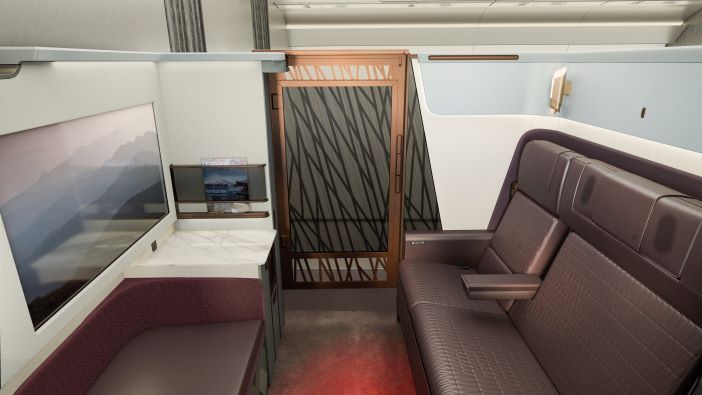
5 innovations for accessible air travel
Air travel is occasionally essential for people, and usually a pleasure, but the experience can be difficult for people with various physical or unseen impairments. Many campaigners, designers and suppliers are working to make air travel better and safer for more people.
For example, the Wheelchair Space and Securement System (WSSS), developed by the University of Virginia Tech in co-operation with Boeing, All Wheels Up and Collins Aerospace, benefits passengers with limited mobility by integrating the space required to secure wheelchairs into adaptable economy seats.
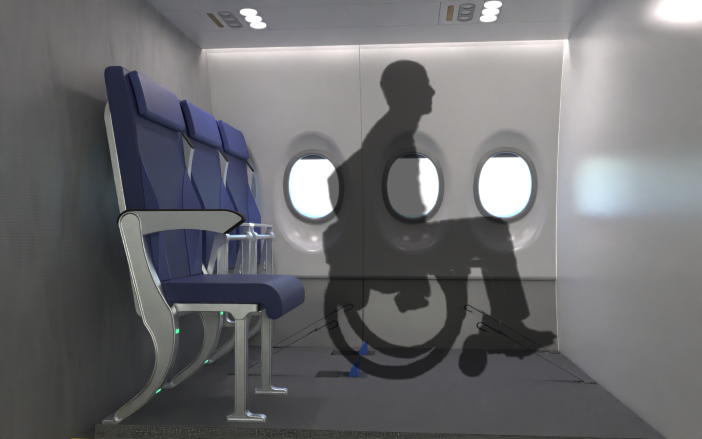
Another shortlisted idea, Collins Aerospace’s ADAPT digital flight experience control system, follows the philosophy of inclusive design by enabling passengers to connect their mobile phones to their seats. The personal device then communicates with active visual sensors such as seat controls, in-flight entertainment controls and the crew, allowing more functions to be accessed with less movement. The system even enables voice recognition or American Sign Language (ASL) recognition.
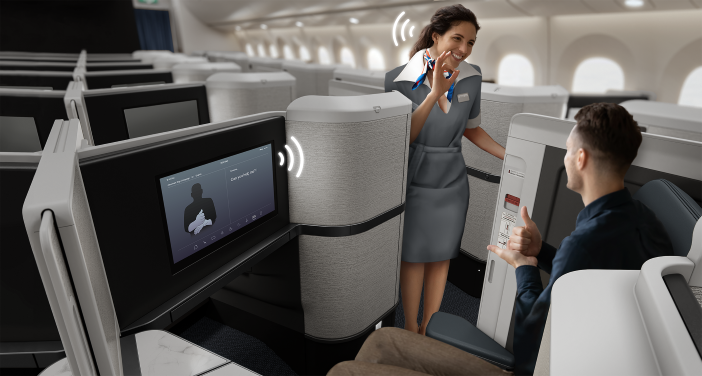
Meanwhile the ACCESS Beam from Airbus is claimed to be the first solution that enables a temporary conversion of the aircraft cabin during ground turnaround, for the transport of wheelchairs. The design offers airlines maximum flexibility, and gives passengers in wheelchairs the safety and comfort of being seated in their own wheelchair during a flight.
Safran Passenger Innovations (SPI), in co-operation with Air New Zealand and Virgin Atlantic, has designed a product that enables passengers with auditory, visual, cognitive and motor impairments to better enjoy the in-flight entertainment, such as TV shows or movies.

Lastly, M-SAAVE is an interdisciplinary student project team at the University of Michigan, dedicated to humanitarian applications of aerospace engineering. Under the leadership of Collins Aerospace, the team has developed a safety system for passengers with reduced mobility. This allows passengers to remain seated in their own wheelchair for the duration of a commercial flight.
Sustainability drives innovation in aircraft cabins
Engineering eco-friendly aircraft cabins is good for helping meet aviation sustainability goals, but is also an enormous challenge. While engineers are required to meet extremely stringent safety protocols, the cabin interiors industry is on a mission to find new ways to cut emissions, use more recycled materials, and reduce the levels of pollution created during manufacturing.
Saving weight in the cabin directly translates into reduced emissions by lowering fuel consumption. Several entrants in the 2024 awards claim to offer significant weight (and therefore emissions) savings, including Zotefoams, Collins Aerospace, Diehl Aviation, Safran Cabin, and a consortium headed by Comprisetec. These companies are using a diverse range of approaches to reduce cabin weight, including ultra-lightweight foam insulators; innovative manufacturing techniques that use less material; new resin-based interior panels; ceiling seat anchor points that replace overhead bins; and water dispensers that replace the need to have bottled water onboard.
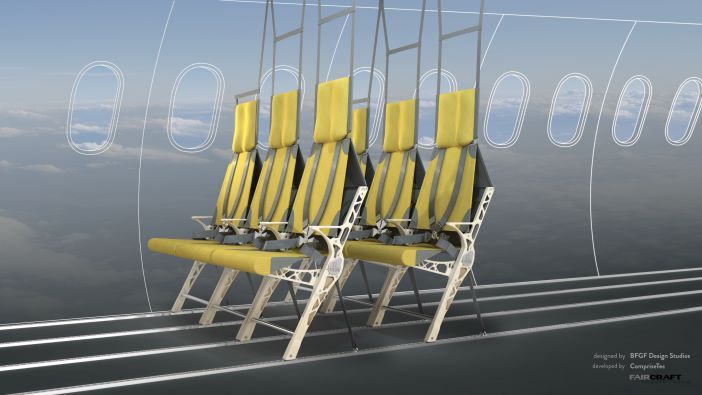
Reusing and recycling materials also offers ways of reducing aviation’s overall environmental impact. Airbus’ C-Suite Circular Business Class, for example, is built around a commitment to use far more recycled materials than in its previous business-class seats. Leading seat manufacturer Recaro has a similar goal with its R Sphere concept that prioritises materials reuse and upcycling. Another shortlister, Gen Phoenix in cooperation with Sabeti Wain Aerospace and Doy Design, has entered a seat dress cover made using a special 100% recycled fabric that is also easy to recycle again. Meanwhile Aircraft Cabin Modification claims its TexEco material is the first 100% natural fibre certified for aircraft cabins.
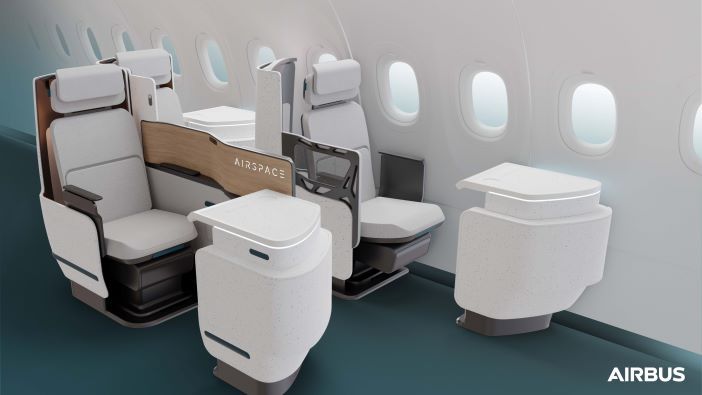
So what’s next?
The international panel of 28 industry experts has now begun assessing the 72 entries in the shortlist, and will vote for which should make it through to the Final round (three entries will make it into each category). The next step, taking place in Hamburg in May, is an in-depth, in-person round of evaluation and interviews. The eight winners are then decided after a final voting round. The prestigious trophies will then be awarded on 28 May at a gala dinner at the Hamburg Chamber of Commerce, as part of Aircraft Interiors Expo.
The Crystal Cabin Award is an initiative of the Hamburg Aviation Cluster. More details are available at www.crystal-cabin-award.com.
The full 2024 Crystal Cabin Awards shortlist
